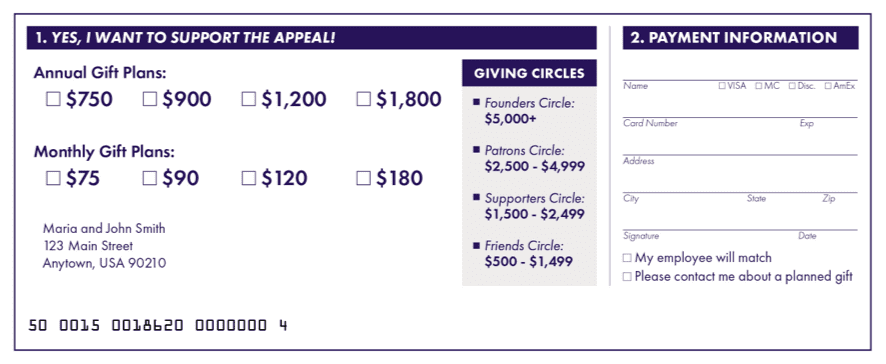Every nonprofit fundraiser hopes there will be donations coming in the door month after month. A recurring donation or monthly giving program can help maintain this steady stream of support.
A recurring giving program accepts donations on a routine and ongoing basis, unlike direct mail appeals or fundraising events with specific timeframes for donations. These donors may give weekly, monthly, or semi-annually throughout the year.
To set any nonprofit organization up for success, fundraisers must know how to encourage donors to make recurring gifts. Donation forms and pages must help donors elevate their sights and understand the impact of recurring donations on the nonprofit mission.
In addition to regular and ongoing donations coming in month after month, an additional benefit of a recurring donation program is that it will help increase donor retention rates. An increase in donor retention will have many positive benefits for any nonprofit.
Fundraisers must learn how to ask for recurring donations, the best ways to invite donors to increase their recurring donation amount, and the types and designs of pledge cards that work best for this type of giving.
How to Ask for Recurring Donations
Instead of starting a new recurring donations program from scratch, it’s best to fix what you already have. Before starting something new, add recurring gift options to appeals your nonprofit already has.
Discover the power of monthly or recurring gift donors based on the donors you already have existing in your database and build from there. This can help increase donor retention.
Use suggested donation amounts in ask strings to help move one-time donors to donors who give month after month.
Remember, let the pledge card do the heavy lifting. Present the suggested amounts on the pledge card, not within the letter itself. You don’t want to break the magic of the story in the letter.
 The Best Ways to Invite Donors to Increase Their Recurring Donation Amount
The Best Ways to Invite Donors to Increase Their Recurring Donation Amount
One way to ensure regular communication with donors is to use automated emails. Donors who receive regular communication are more likely to give and increase their giving.
Email your donors more than you might think. An 8:1 nourishment ratio is best. Fundraisers should consider approximately 34 annual emails to donors, with only 4 of those containing an ask for a donation.
Regular communication will help show those monthly donors what their gifts are making possible for your organization’s mission.
Tools such as AutomateGenius and PowerAutomate can help with regular communication with donors. Imagine coming in daily to drafts of ready-to-edit-and-send emails to donors; this is possible with automation.
In direct mail appeals, the ask strings on the pledge card can help lift the sights of donors. The best ask string is personalized for every donor. Let a tool like AskGenius help personalize these ask strings.
Types and Design of Pledge Cards That Work Best for Recurring Gifts
A pledge card or donation request form is a valuable fundraising tool. It asks potential donors to give a one-time or recurring gift to the non-profit organization, charity, or church that is sending the mailing, running the capital campaign, or hosting the event.
This form collects information needed to complete the donation and help fundraising staff or volunteers steward the donor. A pledge card needs to be easy to fill out and make it easy for the nonprofit to process the gift.
There are generally two types of pledge cards: one with an open-ended or blank ask and one with suggested giving amounts or ask strings. Ask strings work best for most donors; however, an open-ended pledge card is best for major donors.
A pledge card can be an incredible tool for encouraging recurring donations. Instead of merely listing ask strings for one-time contributions, it also lists them for monthly ongoing donations.
The Ultimate Guide to Fundraising Pledge Cards offers more insight into pledge cards for fundraisers seeking further information about this special tool. Some tools, such as , can help automate the process of setting suggested recurring gift amounts.

Organizations should set up online donation forms to accept recurring donations in addition to pledge cards. By setting the donation page up to first offer donors the opportunity to make an ongoing gift instead of a one-time gift, nonprofits can raise more money for their important causes.
The donation process should be easy for donors to give, whether they are giving by credit cards or other giving vehicles.
Statistics show that 57% of donors are already enrolled in a recurring giving program, so they will feel natural when you ask them to enroll in your recurring gift program. We live in a subscription-based world, so adding monthly donations will feel natural to them.
The average monthly recurring gift is $52, and the average one-time gift is $128. It is easy to see the impact of recurring donations on nonprofit missions.
Recurring donors give more and are less likely to lapse, two great benefits of starting or growing a recurring gift program. Start including recurring gift options as part of your fundraising campaign today to increase donations to your worthy cause.
More Resources on Recurring Gifts
Learn more about recurring donations in the webinar: How to Get and Retain Recurring Donors. For more information from the AskGenius team, visit the webinar library. This library contains resources and insights for fundraisers at all levels; you can access it anytime!
















